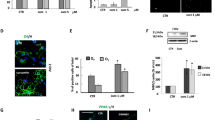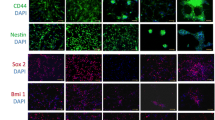Abstract
Curcumin (diferuloyl), from the Indian spice turmeric, reduces oxidative damage and induces apoptosis. Utilizing DNA microarrays, we have demonstrated that a low (5 μM) dose of curcumin added to a mixture of astrocytes and oligodendrocytes (C6 rat glioma cells) in culture for 24 and 48 h significantly modulates gene expression in four primary pathways: oxidative stress, cell cycle control, and DNA transcription and metabolism. Contribution of the pentose phosphate pathway to the pool of NADH upregulates glutathione and activates aldehyde oxidase. We have identified also several new genes, up- or downregulated by curcumin, namely, aldo-keto reductase, glucose-6-phosphate dehydrogenase, and aldehyde oxidase that protect against oxidative stress. The identification of several new cell cycle control genes, including the apoptosis-related protein (pirin) and insulin-like growth factor (IGF), and of the neurofilament M protein involved in neurogenesis suggests that curcumin may have applicability in the treatment of a spectrum of neurodegenerative diseases.








Similar content being viewed by others
References
Selvam C, Jachak SM, Thilagavathi R, et al (2005) Design, synthesis, biological evaluation and molecular docking of curcumin analogues as antioxidant, cyclooxygenase inhibitory and anti-inflammatory agents. Bioorg Med Chem Lett 15:1793–1797
Biswas SK, McClure D, Jimenez LA, et al (2005) Curcumin induces glutathione biosynthesis and inhibits NF-kappaβ activation and interleukin-8 release in alveolar epithelial cells: mechanism of free radical scavenging activity. Antioxid Redox Signal 7:32–41
Huang TS, Lee SC, Lin JK (1991) Suppression of c-Jun/AP-1 activation by an inhibitor of tumor promotion in mouse fibroblast cells. Proc Natl Acad Sci USA 88:5292–5296
Ramachandran C, Rodriguez S, Ramachandran R, et al (2005) Expression profiles of apoptotic genes induced by curcumin in human breast cancer and mammary epithelial cell lines. Anticancer Res 25:3293–3302
Cole GM, Teter B, Frautschy SA (2007) Neuroprotective effects of curcumin. Adv Exp Med Biol 595:197–212
Yang F, Lim GP, Begum AN, et al (2005) Curcumin inhibits formation of amyloid beta oligomers and fibrils, binds plaques, and reduces amyloid in vivo. J Biol Chem 280:5892–5901
Scapagnini G, Colombrita C, Amadio M, et al (2006) Curcumin activates defensive genes and protects neurons against oxidative stress. Antioxid Redox Signal 8:395–403
Al-Omar FA, Nagi MN, Abdulgadir MM, et al (2006) Immediate and delayed treatments with curcumin prevents forebrain ischemia-induced neuronal damage and oxidative insult in the rat hypothalamus. Neurochem Res 31:611–618
Xu Y, Ku B, Cui L, et al (2007) Curcumin reverses impaired hippocampal neurogenesis and increases serotonin receptor 1A mRNA and brain-derived neurotrophic factor expression in chronically stressed rats. Brain Res 1162:9–18
Ambegaokar SS, Wu L, Alamshahi K, et al (2003) Curcumin inhibits dose-dependently and time-dependently neuroglial cell proliferation and growth. Neuro Endocrinol Lett 24:469–473
Gouw A, Panchal H, Ho J, et al (2008) Neurogenesis from Neuroglia: Role of Epidermal Growth Factor in neuroglial dedifferentiation and transdifferentiation into neuronal cells. FASEB J (Accepted for Presentation at FASEB Conference, San Diego, April 5–9, 2008)
Parker KK, Norenberg MD, Vernadakis A (l980) Transdifferentiation of C-6 glial cells in culture. Science 208:179–181
Vernadakis A (1996) Glia-neuron intercommunication and synaptic plasticity. Prog Neurobiol 49:185–214
Kumar S, Weingarten DP, Callahan JW, et al (1984) Regulation of mRNAs for three enzymes in the glial cell model C6 cell line. J Neurochem 43:1455–1463
Wu Z, Irizarry RA, Gentleman R, et al (2004) A model-based background adjustment for oligonucleotide expression arrays. J Am Stat Assoc 99:909–917
Dugas JC, Tai YC, Speed TP, et al (2006) Functional genomic analysis of oligodendrocyte differentiation. J Neurosci 26:10967–10983
Smyth GK (2004) Linear models and empirical Bayes methods for assessing differential expression in microarray experiments. Stat Appl Genet Mol Biol 3:Article 3 Epub 2004
Van der Laan MJ, Pollard KS (2003) A new algorithm for hybrid hierarchical clustering with visualization and the bootstrap. J Stat Plan Infer 117: 275–303
Tomita M, Holman BJ, Santoro CP, et al (2005) Astrocyte production of the chemokine macrophage inflammatory protein-2 is inhibited by the spice principle curcumin at the level of gene transcription. J Neuroinflamm 2:8
Kang SK, Cha SH, Jeon HG (2006) Curcumin-induced histone hypoacetylation enhances caspase-3-dependent glioma cell death and neurogenesis of neural progenitor cells. Stem Cells Dev 15:165–174
Yates MS, Kwak MK, Egner PA, et al (2006) Potent protection against aflatoxin-induced tumorigenesis through induction of Nrf2-regulated pathways by the triterpenoid 1-[2-cyano-3,12-dioxooleana-1,9(11)-dien-28-oyl]imidazole. Cancer Res 66:2488–2494
Syng-Ai C, Kumari AL, Khar A (2004) Effect of curcumin on normal and tumor cells: role of glutathione and bcl-2. Mol Cancer Ther 3:1101–1108
Ross D (2004) Quinone reductases multitasking in the metabolic world. Drug Metab Rev 36:639–654
Piper JT, Singhal SS, Salameh MS, et al (1998) Mechanisms of anticarcinogenic properties of curcumin: the effect of curcumin on glutathione linked detoxification enzymes in rat liver. Int J Biochem Cell Biol 30:445–456
Ji Y, Neverova I, Van Eyk JE, et al (2006) Nitration of tyrosine 92 mediates the activation of rat microsomal glutathione S-transferase by peroxynitrite. J Biol Chem 281:1986–1991
McNally SJ (2007) Curcumin induces heme oxygenase 1 through generation of reactive oxygen species, p38 activation and phosphatase inhibition. Int J Mol Med 19:165–172
Jeong GS, Oh GS, Pae HO, et al (2006) Comparative effects of curcuminoids on endothelial heme oxygenase-1 expression: ortho-methoxy groups are essential to enhance heme oxygenase activity and protection. Exp Mol Med 38:393–400
Balogun E, Hoque M, Gong P, et al (2003) Curcumin activates the haem oxygenase-1 gene via regulation of Nrf2 and the antioxidant-responsive element. Biochem J 371:887–895
Srivastava S, Harter TM, Chandra A, et al (1998) Kinetic studies of FR-1, a growth factor-inducible aldo-keto reductase. Biochemistry 37:12909–12917
Ramana KV, Friedrich B, Tammali R, et al (2005) Requirement of aldose reductase for the hyperglycemic activation of protein kinase C and formation of diacylglycerol in vascular smooth muscle cells. Diabetes 54:818–829
Spolarics Z, Stein DS, Garcia ZC (1996) Endotoxin stimulates hydrogen peroxide detoxifying activity in rat hepatic endothelial cells. Hepatology 24:691–696
Garcia-Nogales P, Almeida A, Fernandez E, et al (1999) Induction of glucose-6-phosphate dehydrogenase by lipopolysaccharide contributes to preventing nitric oxide-mediated glutathione. Neurochemistry 72:1750–1758
Mira L, Maia L, Barreira L, et al (1995) Evidence for free radical generation due to NADH oxidation by aldehyde oxidase during ethanol metabolism. Biochem Biophys 318:53–58
Mikkelsen IM, Mortensen B, Laperche Y, et al (2002) The expression of γ-glutamyltransferase in rat colon carcinoma cells is distinctly regulated during differentiation and oxidative. Mol Cell Biochem 232:87–95
Soo PC, Horng YT, Lai MJ, et al (2007) Pirin regulates pyruvate catabolism by interacting with the pyruvate dehydrogenase E1 subunit and modulating pyruvate dehydrogenase activity. J Bacteriol 189:109–118
Adams M, Jia Z (2005) Structural and biochemical analysis reveal pirins to possess quercetinase activity. J Biol Chem 280:28675–28682
Wendler WM, Kremmer E, Förster R, et al (1997) Identification of pirin, a novel highly conserved nuclear protein. J Biol Chem 272:8482–8489
Pang H, Bartlam M, Zeng Q, et al (2004) Crystal structure of human pirin: an iron-binding nuclear protein and transcription cofactor. J Biol Chem 279:1491–1498
Adachi M, Zhang Y, Zhao X, et al (2004) Synergistic effect of histone deacetylase inhibitors FK228 and m-carboxycinnamic acid bis-hydroxamide with proteasome inhibitors PSI and PS-341 against gastrointestinal adenocarcinoma cells. Clin Cancer Res 10:3853–3862
Howe L, Auston D, Grant P, et al (2001) Histone H3 specific acetyltransferases are essential for cell cycle progression. Genes Dev 15:3144–3154
Beevers CS, Li F, Liu L, et al (2006) Curcumin inhibits the mammalian target of rapamycin-mediated signaling pathways in cancer cells. Int J Cancer 119:757–764
Timiras PS, Yaghmaie F, Saeed O, et al (2005) The ageing phenome: caloric restriction and hormones promote neural cell survival, growth and dedifferentiation. Mech Ageing Dev 126:3–9
Doetsch F, Caille I, Lim DA, et al (1999) Subventricular zone astrocytes are neural stem cells in the adult mammalian brain. Cell 97:703–716
Kempermann G (2006) Adult neurogenesis: stem cells and neuronal development in the adult brain. Oxford University Press, New York
Gouw A, Panchal H, Mahuron K, et al (2008) The potential role of Epidermal Growth Factor (EGF) and Curcumin in transforming neuroglia into neurons. Endocrinology (Accepted for Presentation at Endocrinology Conference, San Francisco, June 15–18, 2008)
Lim GP, Chu T, Yang F, et al (2001) The curry spice curcumin reduces oxidative damage and amyloid pathology in an Alzheimer transgenic mouse. J Neurosci 21:8370–8377
Nakamura S, Kawamata T, Akiguchi I, et al (1990) Expression of monoamine oxidase B activity in astrocytes of senile plaques. Acta Neuropathol 80:419–425
Saura J, Luque JM, Cesura AM, et al (1994) Increased monoamine oxidase B activity in plaque-associated astrocytes of Alzheimer brains revealed by quantitative enzyme radioautography. Neuroscience 62:15–30
Acknowledgment
This study was supported by NIH-AG19145 grant.
Author information
Authors and Affiliations
Corresponding author
Rights and permissions
About this article
Cite this article
Panchal, H.D., Vranizan, K., Lee, C.Y. et al. Early Anti-Oxidative and Anti-Proliferative Curcumin Effects on Neuroglioma Cells Suggest Therapeutic Targets. Neurochem Res 33, 1701–1710 (2008). https://doi.org/10.1007/s11064-008-9608-x
Received:
Accepted:
Published:
Issue Date:
DOI: https://doi.org/10.1007/s11064-008-9608-x




